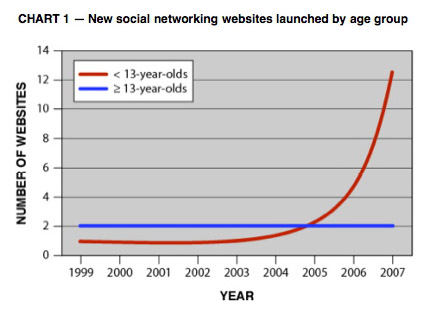[The following is an article I wrote for the October 2008 issue of Playthings Magazine. For those unfamiliar with Playthings, it is the oldest (over 105 years in circulation!) and most widely respected professional toy magazine in all of North America. Playthings reports on the business of play as well as trends that not only impact the toy industry but also children across the globe.]
Social networking, social media, virtual worlds; the Web 2.0 world is on fire, and sites that touch on some part of social media are rapidly growing. Sites that allow individuals to come together, form online communities, and share thoughts and different media types in a virtual way are feeding this ever-changing way to engage with others online.
Plain and simple, people are social creatures. It’s wired into our being. The concept of social networking is not new. It’s been part of our DNA since the dawn of time. Some researchers think that our desire as humans to socialize is an instinct that plays a part in our survival. Only recently has the term “social†been applied to interacting online, allowing individuals to become virtually engaged with others who share common interests across the street or around the globe. And social network destinations are not just for adults and business people, they’re of great interest to kids. Many adults may first have become aware of social networking sites through high profile business acquisitions with noteworthy online companies like MySpace or Club Penguin. Kids, on the other hand, often learn about child-friendly equivalents by word of mouth, from friends at school or the playground.
But just what are the current growth trends? What is the makeup of existing social networking sites today and how—and better yet, why—are kids interested in them? Where are the new opportunities yet to be explored by future businesses? How can a traditional toy business better integrate these new virtual play patterns into existing physical products?
Worlds worth watching
One way to begin chipping away at these questions is to take a look at the wealth of social network products available on the market today. There are literally dozens of sites that people young and old use.
In fact, once a list of social networking sites is identified, a clear demographic split can be seen, and two distinct user groups emerge. One group includes children ages 12 and under; the other includes teens between the ages of 13 and 18.
What is this age group distinction about? In part, the separation has to do with privacy laws that protect young children online. Another factor is that each group comes to these products with a different set of social interests. There are also differences in communication style across the age groups as well as access to and understanding of different technology types.
Before building our list of sites, it’s important to identify the critical social networking features these destinations have in common. The criteria used for this article includes features that allow its user base to communicate with one another in a real time or a delayed manner using open chat, filtered chat, or canned chat —the three main methods of communicating online through such sites. The ability to communicate with other members in these sites is usually, though not always, accomplished through interacting in a virtual world. First, let’s take a look at a list of destinations that appeal to children age 12 and under.
Next, a similar list can be created for popular social networking services that appeal to users between the ages of 13 and 18. The method of communication in these sites for older users tends to be more open-ended and less likely to be monitored or filtered when compared to sites for their younger counterparts.
When the above two sets of data are mapped out over time and placed on top of each other, adding up the number of new social network products launched within each year for both age groups, some interesting trends present themselves.

[NOTE: This line chart above showing the two sets of historical data layered on top of one another did not make it into the magazine article. I am adding it here to the blog post only. -ST]
It’s impossible to ignore the recent growth in new social networking products launched each year that target children ages 12 and under. In 2007 alone there were at least 13 such products announced for this demographic. And 2008 is shaping up to be a banner year for new announcements. During this year’s Toy Fair, I counted 12 new social networking and virtual world announcements, products that have, for the most part, yet to go live. What’s surprising is that over the same time frame, social networking products that appeal to teens have remained somewhat steady in new business starts and consistent year over year. Yet, both demographics are experiencing significant activity in new membership growth and Web traffic month after month. So why is it that the younger demographic is experiencing a greater surge in business startups? Let’s explore a few theories that may answer this question.
Not all social networking products that are appealing to teens are developed specifically for teens. These destinations are often developed to appeal to audiences over the age of 18, but have found success with users between the ages of 13 and 18. Conversely, almost all sites for kids ages 12 and under are intentionally developed for these younger audiences.
It’s possible that older users of social networking products are more loyal to a specific social networking site, whereas the younger demographic is more transient in its social networking choices, preferring to use multiple sites over time instead of staying with just one.
The younger demographic may have greater turnover in users and shorter life cycles (churn) with social networking products that target them than their older counterparts. In the children’s magazine space, for example, it’s not uncommon to hear that an audience base and related subscriptions changes every 18 months. The same could be true for an online world created for younger audiences.
Many younger social networking services are tied to consumer products like plush toys or are affiliated with on-air television programming, whereas services targeted at older users are usually not. While an older demographic has more expendable income than the younger, it may also be a harder group to sell a specific consumer product to in a social networking manner based on ever changing consumer tastes.
Social network destinations that appeal to our older group may see significant growth in add-on services like widgets and other related micro businesses and technologies, whereas the younger social networking destinations do not have the ability to tie in other, similar business extensions.
While both age groups use avatars to represent themselves in an online world, the younger services rely more heavily on avatar use than services for older users. Representing oneself with an avatar online may have greater appeal with younger users.
Services targeting older users take advantage of additional forms of social engagement, like media exchange (photos, music and video). These are offered in addition to engagement through written communication. Few destinations for younger audiences offer the same opportunity to share different media types.
Social networking services for older users do not need to mask a user’s identity, though identities can be hidden, changed and altered at will. Younger services hide all possibility of making oneself identifiable online. The need to protect the identity of young users is a clear distinction that separates the two groups.
Revenue models differ as well. The services for older users rely heavily on ad-driven models. Some younger services also rely on “in world†advertisement but can also take advantage of tangible product sales and/or monthly subscription models.
A number of toy companies have taken steps into the online social networking world for kids, resulting in varying degrees of success. Some companies simply offer an online destination alone while others offer a tangible product (like a plush toy) together with a virtual product, each touching on a different play pattern or desire. Webkinz World and Club Penguin are often cited as exemplary successes in the kids’ space. Others, less so.
Almost, but not quite right
An offering like Mattel’s Barbie Girls is a high profile example of a site that hit kids’ engagement levels correctly but fell short with the related MP3 product that tied into it. It was a case of a strong online solution with a weak tangible product. Ty’s Beanie Babies 2.0 has the opposite problem. Ty’s plush toys are loved by many a child but its online offering falls short in ongoing engagement after its initial use.
It’s easier to correct an online shortcoming by continuing to evaluate, test, build and expand such sites than it is to correct a problem with a tangible consumer product once it’s in the marketplace, but getting both virtual and physical products correct from the first day of launch is vitally important. In the early days of Club Penguin, before the official launch of the site in October 2005, an earlier iteration of Club Penguin called Penguin Chat existed for a couple of years. It was extremely limited compared to other social networking products offered today. But the creators of Club Penguin continued to build and add to this first step with additional features and games. The same is very much true for Ganz’s Webkinz World. Both sites’ initial offerings were smaller than they are today, built largely on a shoestring budget, sweat equity and love, but both offered an acceptable level of quality content, quality experience and user engagement with kids right from the start.
Looking towards 2009, we will continue to see even more ways to engage in virtual worlds, resulting in unique and specialized methods of socializing and participating in communities online. Some technology products for holiday 2008 will connect to the Web via USB ports. Additional connectivity through cell phones or other mobile technologies could provide ongoing social opportunities when access to a computer is not available. Stay tuned for more innovation and opportunity in this ever-changing, ever-expanding online world for children, teens and adults alike.
Average Rating: 4.8 out of 5 based on 222 user reviews.



 There’s a cell phone ad on TV currently that asks why we still refer to our cell phones as “phones” since their capabilities have expanded far beyond that of just making a call. Cell phones today include digital cameras, web browsers, media players, games, and more. As cell phone features continue to expand, so too does the latest game playing device announcement from Nintendo.
There’s a cell phone ad on TV currently that asks why we still refer to our cell phones as “phones” since their capabilities have expanded far beyond that of just making a call. Cell phones today include digital cameras, web browsers, media players, games, and more. As cell phone features continue to expand, so too does the latest game playing device announcement from Nintendo. This past week I was at Northwestern University to participate in a conference called
This past week I was at Northwestern University to participate in a conference called